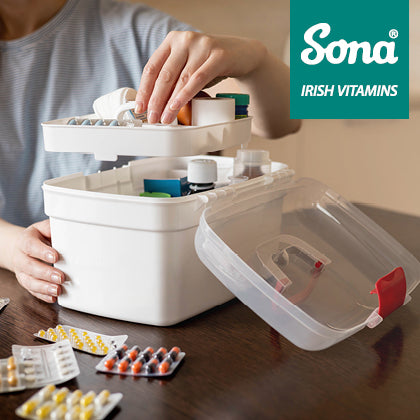The Best Practices for Storing Vitamins to Maximize Their Effectiveness
Storing vitamins properly is crucial to ensure they deliver their intended health benefits without degradation. Recent research from Purdue University underscores the importance of keeping your vitamins and supplements in conditions that preserve their potency.
Understanding the Risk of Humidity and Heat Both the kitchen and bathroom are commonly used for storing vitamins but are the worst places due to high levels of humidity and fluctuating temperatures. High humidity can trigger a process known as deliquescence, where water-soluble substances like certain vitamins, dissolve. Vitamins prone to this process include vitamin C and some B vitamins (all water-soluble vitamins), which can degrade quickly in such environments, significantly reducing their effectiveness and shelf life.
Common activities in kitchens and bathrooms, like cooking and showering, can increase the humidity and heat, turning these spots into hotbeds for moisture spikes. Researchers point out that opening and closing vitamin containers in these environments can trap moisture inside, accelerating the degradation process.
Maintain Original Containers
While it might seem convenient to transfer vitamins into smaller containers, it's best to keep them in their original packaging. Certain vitamins require specific types of containers, like dark-coloured glass bottles, to preserve their effectiveness. Therefore, transferring vitamins to smaller pill cases or combining them with other supplements should be avoided to ensure they stay potent.
Proper Storage Tips: To avoid the degradation of vitamins, it is essential to store them in a cool, dry place. Here are some practical tips to help ensure your vitamins remain effective:
- Choose the Right Location: Avoid storage in bathrooms and kitchens. Instead, opt for a bedroom or living room cabinet that is not subject to drastic temperature changes.
- Control Humidity: If the containers your vitamins are packaged in are made of plastic, if not already included, consider adding desiccant packs in the containers to absorb excess moisture and keep the environment dry.
- Protect from Light and Air: Store vitamins in opaque, airtight containers to minimize exposure to light and air, which can also degrade certain vitamins. Dark glass bottles are always the preferred choice.
- Keep Out of Reach of Children: Ensuring vitamins are stored in a place inaccessible to children is crucial to avoid accidental ingestion, which can be harmful.
Signs of Vitamin Degradation It’s vital to recognize the signs that your vitamins may be compromised:
- Liquid in Containers: The presence of moisture can indicate that vitamins have begun to degrade.
- Brown Spots: Particularly on chewable vitamins, brown spots can indicate moisture exposure and potential loss of potency.
- Clumping or Caking: Loke kitchen staples salt or sugar, clumping can suggest that the vitamins have been exposed to moisture.
Contrary to popular belief, refrigerating your vitamins is not advisable unless specifically recommended by the manufacturer. Cold can also contribute to condensation and moisture problems, potentially leading to the same issues as high humidity. Probiotics however can benefit from refrigeration temperatures but only when in glass bottles as otherwise the humidity will destroy them.
Storing your vitamins correctly is more than just prolonging their shelf life; it's about ensuring efficacy when you take them. By following these storage guidelines, you can protect your health investments and ensure you are receiving the full nutritional benefits they offer.
At Sona, your health is our priority, and we understand the importance of maximizing the benefits of your vitamins. We emphasize the crucial role that proper storage plays in preserving the integrity and effectiveness of our products. By grasping the science of vitamin storage, you can confidently trust that every dose from Sona delivers optimal health benefits, aligning with your wellness goals.
References: Purdue University. ScienceDaily

